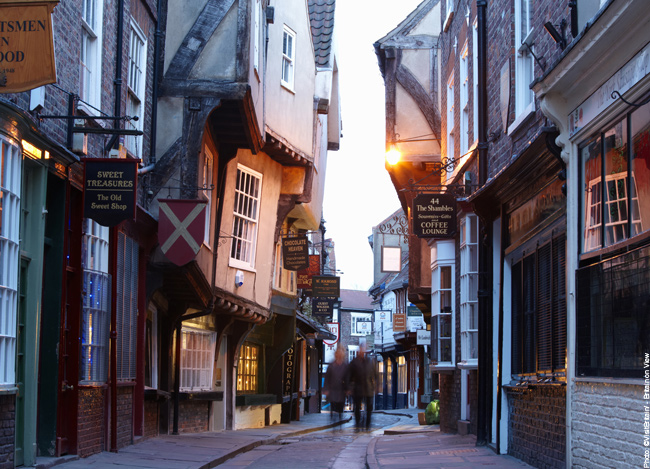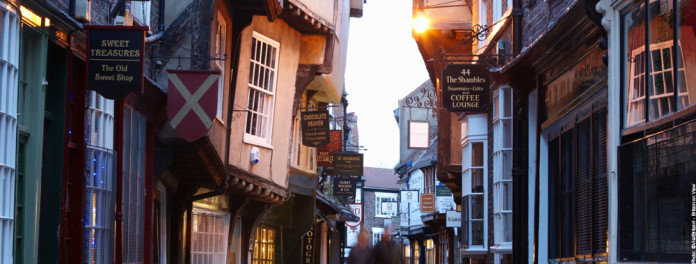From dales to wolds, cities to coasts, literary landscapes to ancient abbeys, Yorkshire offers something to inspire you, whatever your passion

Ask a dozen people what Yorkshire means to them and each will give you a different answer – and they’ll all be right. The incredible variety of its scenery makes Yorkshire popular with visitors who return time and time again. The region takes in the National Parks of the Dales, Moors and Peaks, an area covering 1,000 square miles of beautiful countryside and stunning seascape. Each has its own character.
The limestone hills, pastoral valleys and distinctive network of dry-stone walls of the Dales in the north west contrast with the rolling landscape of the Howardian Hills, an Area of Outstanding Natural Beauty. The heather-clad moorland of the North York Moors stretches towards a coastline characterised by fishing villages, fossil-strewn beaches, sweeping bays and Victorian seaside resorts.
The undulating dips of the Wolds to the east have been celebrated most recently by Bradford-born artist David Hockney, who draws inspiration from the gentle, rolling hills and sweeping skies. Here, the landscape remains unchanged by the passing years and is still accessed by small, winding roads. In contrast, the south and west of the county was the powerhouse of the Industrial Revolution with its skyline of Dickensian factory buildings that appear to grow out of the rugged landscape.
However, the Venetian-style town halls and civic buildings reflect the industrial pride of the area. A perfect example is Piece Hall in Halifax, an architectural gem, built in 1779 as a cloth hall for weavers to sell their wares. New life has been breathed into these Yorkshire towns and cities.
Each boast award-winning attractions, such as the RoyalArmouries in Leeds and the National Media Museum in Bradford. Salts Mill in Saltaire houses the largest retrospective collection of David Hockney’s works and Saltaire itself is a great example of a Victorian model village, created by mill owner and philanthropist Sir Titus Salt.
Long before it appeared on a tourist map, Yorkshire had its fair share of visitors. It has been home to Celts, Romans, Vikings, Normans and Anglo-Saxons. Its main city, York, for centuries England’s second city, is an ensemble of tiny medieval alleys, castle ruins and Roman remains, all enclosed within city walls. The walls themselves offer superb views over the city and York Minster, Britain’s largest Gothic building and seat of the Archbishop of York.
Several major battles were fought on Yorkshire soil, shaping England’s history forever. The bloodiest battle fought on English soil was the Battle of Towton, near Tadcaster, in March 1461 during the Wars of the Roses. The battle left 33,000 Lancastrians and Yorkists dead.
Then, 200 years later in the civil war campaign for the north, one of the largest battles ever fought in England took place. The Battle of Marston Moor was fought in July 1644 between Parliamentarians, Scots and Royalists. Although the battle scars have healed, reminders of this proud northern county’s turbulent past feature heavily.
There are a number of impressive castles including Conisbrough, Skipton, Bolton, Helmsley and Scarborough, which has panoramic views across two bays. Abbeys and ruins too can be found across much of North Yorkshire, many partly destroyed during the reign of Henry VIII.
The World Heritage Site of Fountains Abbey and Studley Royal is one of the most remarkable sites in Europe. Sheltered in a secluded valley, it houses the spectacular remains of a 12th-century Cistercian abbey with one of the finest surviving monastic watermills in Britain, an Elizabethan mansion and a Georgian water garden.
The Cistercian monks had a talent for finding some superb locations for their abbeys. Rievaulx, near the picturesque market town of Helmsley, was the first Cistercian Abbey to be founded in the north of England in the 12th century. The abbey was once home to the greatest spiritual writer of the Medieval Ages, Aelred of Rievaulx, who described it as, “Everywhere peace, everywhere serenity, and a freedom from the tumult of the world.”
For many, the Dales epitomise Yorkshire. A stroll beside the River Wharfe at Bolton Abbey, stopping off for a pint at the 16th-century Red Lion Inn at Burnsall, makes for a memorable day. Confusingly not an abbey (it is the ruins of a priory that can be seen here), Bolton Abbey is actually a village set on the estate of the Duke and Duchess of Devonshire in the Dales heartland.
The hollow basin of the Hole of Horcum in the North York Moors is a surprising geological feature that looks like a giant crater. In fact, this huge hollow was gouged out by a glacial ice flow. However, legend has it that a local giant, Wade, who was angry with his wife, flung a handful of earth at her, creating what became known as the Hole of Horcum.
In summer, clouds of billowing smoke in the valley below issue from steam trains on the North Yorkshire Moors Railway, a nostalgic way to enjoy the moors scenery from Pickering to Whitby. Alternatively, a well-trodden National Trail is the 110-mile Cleveland Way, starting at Helmsley and finishing at the seaside resort of Filey. It skirts the North York Moors and continues down the coastline. The charming fishing village of Staithes, where one-time resident Captain Cook found his sea legs, has long been a magnet for artists due to its wild seas and huddled cottages.
The oldest part of the village lies at the foot of Cowbar Nab where fisherman’s cobbles – the traditional fishing boats of the area – still bob up and down in the harbour. Equally attractive is Robin Hood’s Bay, a once-notorious smuggling haunt, with its red, pan-tiled houses descending higgledy-piggledy from the clifftop to the edge of the North Sea. The Bay Hotel on the harbour front is a favourite spot.
The coastal resort of Whitby also draws many visitors with its historical associations to Captain Cook and HMS Endeavour, atmospheric ruins and relaxed charm. The Magpie Cafe boasts the best fish and chips in the UK and judging by the queues outside, they’re not far wrong.
Flamborough Head, by the coast, is one of the most famous sights in England and nearby Bempton Cliffs, home to a Royal Society for the Protection of Birds reserve, is the place to spot puffins, gannets and guillemots. The gently undulating countryside of the Wolds is perfect for walking, including the 79-mile Wolds Way National Trail. Tranquil villages like Warter, Kirby Underdale and Sledmere seem to stand still in time. For a pub lunch, the historic Pipe & Glass Inn in South Dalton overlooks acres of parkland.
For literary buffs, Yorkshire won’t disappoint. The Brontë’s family home at Haworth is today a site of pilgrimage. Just a few miles south of here, in Brontë Country, is the windswept Top Withens, believed to be the inspiration for Emily Brontë’s Wuthering Heights.
Alf Wight in turn immortalised the Dales when, under the name of James Herriot, he penned his tales of a Yorkshire vet. And, when you watch the mist roll off the sea into Whitby, it is easy to see how Bram Stoker drew inspiration for Dracula as he sat in a hotel looking across at Whitby Abbey.
From the spa town of Harrogate with its boutique shops and Victorian Turkish baths, to the attractive market town of Beverley with its Victorian terraced houses, Yorkshire is also an architectural showcase. Harewood House, home to the Queen’s cousin, the Earl of Harewood, is one of the treasure houses of England. Its magnificent Robert Adam-designed interiors house a priceless collection of art from Titian to Turner. Despite the grandeur of their interiors, Burton Agnes Hall, an Elizabethan gem, and Sledmere House, in the Wolds, are also both loved and lived-in family homes. Castle Howard has enough to entice visitors with its impressive architecture and dramatic lakeside setting.
However, it will be forever etched in many minds as the home of the Flytes in the 1980s TV adaptation of Evelyn Waugh’s Brideshead Revisited. The estate fulfilled the same role in the 2008 film version, too.
This feeling of déjà vu stretches across the region with other areas featuring in films and TV shows as well. The North Yorkshire Moors station at Goathland starred in the film version of Harry Potter and the Philosopher’s Stone and was transformed into ‘Aidensfield’ in the TV series Heartbeat. Calendar Girls was filmed at Kettlewell in the Dales and the Keighley and Worth Valley Railway found fame in the 1970s film of Edith Nesbit’s The Railway Children with Jenny Agutter. For more than 30 years, the comedy TV series, Last of the Summer Wine, played out at Holmfirth.
The natural landscape is enhanced by several designed gardens including the 500-acre Yorkshire Sculpture Park, the restored Sheffield Botanical Gardens and the gardens at Newby Hall, featuring lovely double herbaceous borders.
Contemporary gardens like RHS Harlow Carr, dominated by water, stone and woodland, complement the surrounding Yorkshire landscape. Similarly, Scampston Walled Garden, near Malton, with its exciting modern feel, sits happily with the adjacent 18th-century Capability Brown park.
Traditional Yorkshire customs thrive, including a sword dancing festival at Flamborough, first introduced by Nordic settlers, and the 200-year-old Egton Bridge Gooseberry Show, near Whitby. The creation of the Denby Dale Pie, baked by the villagers of Denby Dale, near Huddersfield, to celebrate King George III’s recovery from mental illness, is a tradition that continues today.
Undoubtedly the most famous culinary export, however, is Yorkshire pudding. Traditionally, this savoury dish would be served before the meat in a meal, the idea being that people would be less hungry and the meat would go further.
The bizarre Yorkshire Pudding Boat Race involves the villagers of Brawby, near Malton, competing in giant-sized Yorkshire puddings, coated in yacht varnish to stop them going soggy in the water.
However, there is more to the region than Yorkshire pudding. As the Yorkshire-born patron of the award-winning Star Inn at Harome, Andrew Pern, says, “As a chef, I couldn’t have a better pantry on my doorstep. The game from the North York Moors, fish from the North Sea, fruit and vegetables from the Vale of York and meat from Ryedale. I have the pleasure of cooking with this and offering it to guests visiting our little part of Yorkshire. How lucky is that?”
Alternatively, for tea and cake, there is no other place to go than Bettys Cafe Tea Rooms, a Yorkshire institution. There are now seven of them, but it was Bettys in York that was the place to go during the Second World War when the basement bar became a regular haunt for the dapper, young Canadian airmen, stationed outside York, and young local lasses. Here, 500 airmen etched their names on the back of a mirror. Years later, those who survived the war returned with their families to show them these same signatures.
It’s just one of the reasons visitors come back to Yorkshire – but there are also many more.
Discover our editor’s favourite places to visit in Yorkshire!
Discover more incredible facts about our country in every issue of BRITAIN Magazine.






 © 2024
© 2024